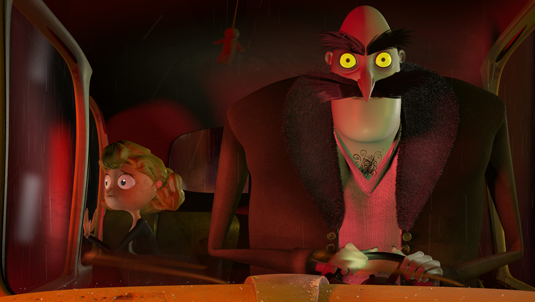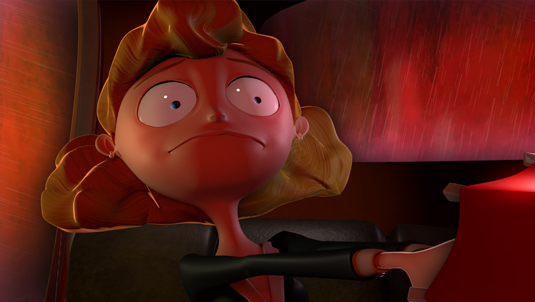Fun serial-killer short is brilliantly executed
If you've got a warped sense of fun, you'll love this funny short with a clever twist - and won't believe it was made by a student! We chat to Paolo Cogliati to find out how it was made.
A serial killer is on the loose! But all may not be as obvious as it seems in this brilliant 3D short by Ringling College of Art and Design student Paolo Cogliati.
The film tells the tale of a young woman who decides to avoid the rain and catch a taxi home instead. As she flags one down, her mobile phone informs her of a taxi serial killer, who's still at large. Panicking, she desperately looks for an escape. Question is, does she find one?
We caught up with director Paolo Cogliati to ask him a little bit about the short's production...
What were the film’s influences, both story-wise and stylistically?
"Serial Taxi was influenced primarily from a personal experience I had in Russia, when a taxi driver that was supposed to take me to the airport early in the morning, decided to take an alternate route through the desolate outskirts of St. Petersburg in order to make more money on the ride. Had he said a single word, and refrained from staring at me through the rearview mirror, I would have probably understood what he was doing instead of thinking he was going to kill me…
Serial Taxi was influenced primarily from a personal experience I had in Russia
"Stylistically, the film was primarily influenced by live-action films, most heavily from The Game, A Night on Earth, and The Bone Collector, which I reference in small ways in the film. Although those were the main films that influenced Serial Taxi, it became a goal of mine to play homage to that genre itself, and include some of the obvious film-clichés you can find in many of these movies -- like a close up of a car lock bolting down; after realising that those key moments really do fuel your fear when you find yourself in a similar situation."

What did you do on the short and what was the hardest job?
"I was responsible for the entire short, from story to final render. The hardest job, which continued to challenge me throughout the entire production, was a personal goal I had set from the start. I had in mind from the very beginning the idea that the style of animation, mood and lighting should shift accordingly to the female character’s inner emotional curve.
The style of animation should shift according to the female character
"As the film started, I tried to keep the animation style of the film more realistic, while still retaining a cartoon quality. As her insecurities take over, and her emotional curve starts to rise through fear and doubt, I tried to shift the animation, lighting and tempo of the film to reflect her inner conflict and become more cartoony and exaggerated, showcasing her fragile emotional state through the shift of environment mood, lighting, and a slightly more exaggerated style of animation.
Daily design news, reviews, how-tos and more, as picked by the editors.

"In the third act, you can tell the style and colors revert back towards the more grounded feeling of the first act. This aspect affected all areas of production forcing me to carefully plan the next step in the process before finishing the one I was currently working on.
How long did the animation take to produce?
"I had a one school year in which to create this production. The animation period was a total of 5 weeks, which saw 42 shots with two characters in the majority of them."
What 3D software did you use and why?
"The main software for my film was Autodesk Maya, Pixar’s Renderman, Adobe Premiere Pro, Photoshop and After Effects. I used Flash for varied versions of the animatic and pre-animation planning, animating many of my shots in 2D prior to going into the CG portion to experiment with timing, silhouettes and facial nuances."

What was the most useful piece of software and why?
"Considering that a large portion of my film takes place inside a taxi, I decided the area I could shave the most time off was rigging. I rigged the body of all three characters using a basic TSM (The Set Up Machine) set-up along with custom additives provided by my school. This allowed me to quickly start animating from the waist down, and worry about the finer tuning of the rigs as production deemed necessary.
I rigged the body of all three characters using a basic TSM (The Set Up Machine) set-up
"A vital addition to the rig was creating a small joint set-up that would make subtle motions such as breathing easier to control and convey through a duplicate mesh that was blendshaped to the body geometry."

What was the most impressive technical aspect of the project and how was it achieved using 3D software?
"During the animation phase of the film, I discovered that my female character’s eyelashes had broken and wouldn't work, even when re-created through wrap deformers or blendshapes. Seeking both help from teachers, and online research, I still could not find a solution to the problem and spent a good week allocated for animation trying to solve the problem.
"Eventually I key framed the eyelashes in every single shot of the film. It was impressive for the wrong reasons, but it definitely impressed teachers and friends!

"On a more technical side, my largest mountain to climb was the large-scale environment that the characters had to drive through. Modeling a large, city block, even if looping, and simulating water for all 42 shots would have been close to impossible both due to render time, and the time-based feasibility of being a one-man team. I decided to approach the film with the old “screen behind the car” trick, which old movies used to rely on, only in a CG fashion.
"The entire film was set-up with no background elements except for the taxi itself. I then modeled a long city street and animated a camera in varied positions with some shakes and turns for compositing purposes. The rain and water effects were achieved in with After Effects particle simulations mixed with a large amount of Render Layers, where I was then able to composite everything together and loop the environment to feel like the taxi was in motion.
Each shot had a total of approximately 25-30 layers for the background alone
"Each shot had a total of approximately 25-30 layers for the background alone. These included smoke and rain effects, as well as manually rotoscoped layer duplicates to add highlights or shadows, facial tones or specular highlights to both characters and elements that, for some reason or another, did not render.
"For the same rendering constraints, I opted for texture cards to create Boris’s moustache with a floating set of constrained joints. I then rendered his moustache alone on an alpha channel for every shot to composite the highlights and stylized texture I wanted it to have.

Did you make any mistakes during production?
"The largest mistake I made, especially considering that lighting had not been a focus of mine through my studies, was underestimating how much time and energy a well fleshed-out color script of your film can save you.
"Having to undertake every step of production made this phase incredibly easy to overlook, and although I had a general idea of the path I wanted the color and mood of the film to take, I did not have cohesive and researched color beats that could help as a road map while lighting.

"For this, I sought help from my friend and illustrator James Cassettari. We spent approximately 2-3 weeks together in-between classes and lab hours discussing and deciding how to best portray the girl’s inner emotions through the tonal changes in the film, and what key colors to use throughout. He then fleshed color beats based off of our conversations and collection of materials, that I then used to not only use as a roadmap for each shot, but also to make sure that the film’s lighting was cohesive and well transitioned.
Did you use or develop any new or notable techniques?
"Having the taxi driver so close to screen throughout the film meant that his facial rig needed to be able to emote more than the average exercise rigs we usually create.
"To achieve this I experimented by creating a rudimental facial set up through skinning, which I then used to create a broader range of individual shapes that were further sculpted to achieve a broader range of blendshapes in addition to the standard amount of shapes we build in our characters.

"To make sure I could add nuances with his eye-bags, cheeks and even individual moustache strands (that were nothing more than texture cards) I then applied a set of Taffy deformers to individual groups of vertices to manipulate on top of the facial controls I already had.
What are you working on now?
I am currently a CG Animation Intern at LAIKA Entertainment, working on production for their upcoming feature film “The BoxTrolls” coming to theatres in 2014. The teaser was recently released, so if you haven’t given that a look yet, you definitely should!
Liked this? Read these!
- Best 3D movies of 2013
- 25 top free 3D models
- Blender tutorials: ways to create cool 3D effects
Have you seen any brilliant 3D shorts recently? Let us know in the comments below!

The Creative Bloq team is made up of a group of art and design enthusiasts, and has changed and evolved since Creative Bloq began back in 2012. The current website team consists of eight full-time members of staff: Editor Georgia Coggan, Deputy Editor Rosie Hilder, Ecommerce Editor Beren Neale, Senior News Editor Daniel Piper, Editor, Digital Art and 3D Ian Dean, Tech Reviews Editor Erlingur Einarsson, Ecommerce Writer Beth Nicholls and Staff Writer Natalie Fear, as well as a roster of freelancers from around the world. The ImagineFX magazine team also pitch in, ensuring that content from leading digital art publication ImagineFX is represented on Creative Bloq.
